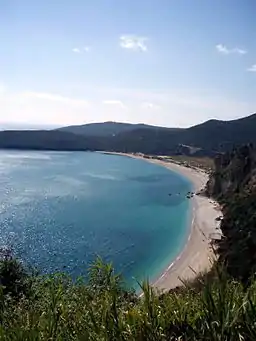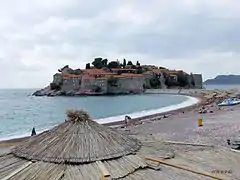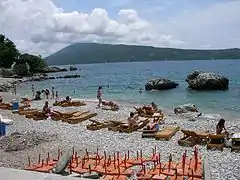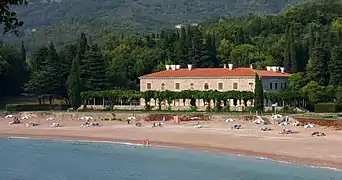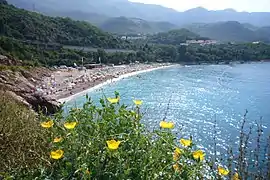Tourism in Montenegro
Montenegro is one of the fastest-growing tourist destinations.[1] In 2007, over a million tourists visited Montenegro, making some 7.3 million overnight stays (23% increase, compared to 2006). This accounted for some 480 million euros in tourism revenue in 2007 (39% increase, compared to previous year). In 2015, tourism realised over 1.7 million arrivals, with a further increase in 2016.[2] In the same year, the coastal town of Kotor was named the best city to visit by Lonely Planet,[3] whereas the country itself is continuously included in touristic top lists. With a total of 1.8 million visitors in 2016, the nation became the 36th (out of 47 countries) most popular country to travel to in Europe.[4] Montenegro was further visited by over 2 million tourists in 2017. The Government aims to attract greenfield investments, which should make best use of undeveloped parts of the coast, such as Jaz Beach, Velika Plaža, Ada Bojana and Buljarica.
Montenegro can be presented as a destination offering a variety of attractions and all-year tourism is possible by publicizing its varied features. Therefore, the Tourism Masterplan of Montenegro is also paving the way for a national development program for nature based tourism, especially hiking and biking, with new infrastructure and services. The realisation of a 3-year-program was started in 2007.
Main points of interest
Coastal region
North Coast region
This notable coastal region is of primary interest to tourists in Montenegro. The Montenegrin Adriatic coast is 295 km long, with 72 km of beaches, and with many well-preserved ancient old towns. The main attractions along the north coast are:
- The old Town of Herceg Novi
- The old town of Kotor, listed with UNESCO world heritage sites
- Boka Kotorska (Bay of Kotor), with the ancient small town of Perast
- Porto Montenegro – Luxury Yacht Marina in Tivat (only city on Montenegrin coast to have airport)
- The old town of Budva, a well preserved old town
- Sveti Stefan, a small island hamlet turned into a luxury hotel
- Town Petrovac near Budva
South Coast region
The South Coast region of Montenegro is considered one of the great new "discoveries" among world tourists. In January 2010, The New York Times ranked the Ulcinj South Coast region of Montenegro, including Velika Plaza, Ada Bojana, and the Hotel Mediteran of Ulcinj, as among the "Top 31 Places to Go in 2010" as part of a worldwide ranking of tourism destinations
The South Coast region, centered in Ulcinj, is popular in part due to the "Blue Flag beach" sandy beaches, eco-adventure activities, ancient fortress-cities, and vibrant nightlife. These destinations include:
- The old town of Ulcinj with its prominent battlements and Cyclopean walls, bustling nightlife and sea-side strand, and home of the Montenegro's longest pristine beach, Velika Plaza.
- The old town of Bar, Montenegro with its "living museum" at Stari Bar.
- Ada Bojana at the very south of Montenegro's coastline, with its famed daily fresh catch featured at the area's seafood riverside restaurants.16 km from Ulcinj.
- The vast water body and wildlife reserve Skadar Lake at Ulcinj's Salt Flats, one of the largest nesting places on the European continent for migratory birds.
- The pebble beach and massive olive groves at Valdanos.
- The beach, sea caves and pine resin in the air at Ulcinj's Ladies Beach, that for generations locals have known promise cures for infertility and other ailments.
- The only deep water harbor and commercial port in Montenegro, at Bar.
- Beaches, fortresses and villages on Skadar Lake
Northern region
The northern region is the centre of Montenegrin mountain tourism. It has ski resorts, and is popular for its untouched nature. The entire area of Durmitor mountain and the Tara river canyon is protected as a national park, and listed with UNESCO world heritage sites.
Destinations in the north are:
- The town of Pljevlja with the coat of arms of the Đurđevića Tara Bridge over the Tara (river), the largest canyon in Europe, the second-deepest canyon in the world, and the most beautiful canyon in the world in terms of natural environment.The canyon is known for the attraction of countless fast springs from the rocks during rafting.
- Ljubišnja triple Highland mountain chain and largest forest mountain range in Montenegro with the center in the village of Bobovo. T Sandica Ubo the historic hamlet on the cliffs of the Tara (river) is part of the Durmitor National Park. Climbing, hiking, photographing unrealistically beautiful forest areas is a tourist practice.The habitat of wild horses is located on Horse field on Ljubisnja.Dairy products and organic food are produced by local farmers.
- Municipium S ... Komini Pljevlja archaeological site from the Roman period found by Arthur Evans.
- Heritage museum Pljevlja the most representative and richest museum in Montenegro with a unique piece of Cage cup.
- Monastery of the Holy Trinity near Pljevlja is famous as a place of pilgrimage known as a monastery whose a very famous medieval Enlightenment fraternity has guarded the bishop's scepter and a chest with holy bridges of one hand of Saint Sava for centuries which were moved to Church of Saint Sava.
- Husein-paša's Mosque in Pljevlja with the famous blue artistic arabesque on the celling of the tallest dome of the mosque andwith the tallest minaret (42m) in the Balkans.
- Monumental memorial complex dedicated to the partisan fighters killed during the Battle of Pljevlja, the tallest monument to anti-fascist movement in the Socialist Federal Republic of Yugoslavia.
- Memorial monument dedicated to the founding of Brigate Garibaldi formed in the valley of the village Mrzovici near Pljevlja opened with a ceremony with respect by the Italian president Sandro Pertini.
- The town of Žabljak on the Durmitor mountain, the most popular mountain tourism destination in Montenegro
- The town of Kolašin, another tourist destination, near the Biogradska Gora national park, the Bjelasica mountain and the ski-resort Bjelasica
- Biogradska Gora, with Biogradsko Lake, a national park and untouched virgin forest.
Central region
Although it is the most densely populated area of Montenegro, the central region has fewer tourist attractions. Notable are:
- Ostrog monastery, an Orthodox pilgrimage site
- Archeological remains of Duklja (Doclea) from Roman times outside Podgorica
- Cetinje, the historic capital of Montenegro
- Mount Lovćen, the national park and Petar II Petrović-Njegoš's Mausoleum have views of the surrounding area
Beaches
The length of coastline of Montenegro is 293 km. It has 73 km of beaches, there are over 120 such beaches. There are varying beach styles from sand to pebbles of differing lengths.
Ulcinj
The coast line of Ulcinj is 32 km long. It has more than 10 beaches. Ada Bojana is a river island. It is a triangle shape with sea from one side. The beach is sandy and long. Velika Plaza is the longest beach in Montenegro, one of the warmest and most beautiful beaches on the Adriatic Sea. It is 12 km long and it is covered with sand. It is very shallow. Small city beach is as same as Velika Plaza but it is not so long. Valdanos is little cove with pebbly beach and beautiful flora around it.
Bar
Bar Riviera is 44 km long and has got 9 km of beaches. There are more than 20 beaches but Bar has got 2 beaches on the lakeside. The main beach in Bar is Sutomore beach. It's 1 km long and is covered with sand. Canj beach is 1 km long and is a tourist location. The beach is covered with fine sand but the sea bottom is covered with round rocky pebbles. Queen's beach is very near Canj but it can be only approached from sea. Red beach is specific because it is covered with red round pebbles and the view from it is outstanding. Zukotrlica beach is over 1 km long and it is near the city. It is covered with white pebbles and in the background is little beautiful pine forest. Beach Utjeha is also called "Olive Bay" because there are hundreds of olives in the background. It is covered with pebbles and is very clear. On the lake there are two beaches: Pjesacac and Murici. They are covered with pebbles. The view from there on the Skadar Lake is amazing.
Budva
Budva Riviera has over 25 beaches and they are favourite destination for tourists in Montenegro. The longest beach is Jaz. It's 2.5 km long and is sandy. Mogren beach has specific small pebbles. It consist two little beaches and they are connected with a tunnel. Slovenska beach is 1.5 km long and is covered with sand. There are lot of hotels, restaurants and parks in the background. The Becici beach is long and one of the most beautiful in the Mediterranean, it is sandy. Milocer beach, Queen's beach and Sveti Stefan beach are the most exclusive beaches in Montenegro because of fantastic sand, flora and amazing view on isle-hotel Sveti Stefan. Pterovac beach is quiet long and is covered with little red pebbles. Special attraction there are two little isles and little fortress near beach. Buljarica beach is covered with sand and is 2 km long.
Tivat
There are over 15 small beaches in Tivat. Opatovo is a 200 m long pebble beach. Little lighthouse divides beach in two parts. Beach Plavi Horizonti is perhaps the most famous and beautiful in Tivat. It is 300 m long and covered with small white pebbles. There are two islands near Tivat: The Island of St. Marko and Island of Flowers. They have very nice and attractive beaches.
Kotor
This is the deepest part of Boka Kotorska so there are fewer beaches. There are about 10 small beaches. Morinj beach is very nice pebbly beach with beautiful background and view on bay. Risan beach is a quiet, long and rocky beach. Orahovac is the favourite beach in Kotor. It is pebbly with old stone houses in the background. Trsteno is one of the most beautiful pebbly beach in Montenegro. It is 200 m long with clear water and natural background.
Herceg Novi
Herceg Novi Riviera is 25 km long and it has over 20 beaches. Igalo beach is 1.5 km long and sandy. Rose beach is rocky with very nice forest background. Zanjic beach is one of the most beautiful in Herceg Novi. It is 300 m long and it is covered with white pebbles.
Statistics by year
| Year | Total tourist arrivals | Domestic | Foreign |
|---|---|---|---|
| 2006[5] | 953,961 | 156,857 | 797,071 |
| 2007 | 1,133,432 | 149,294 | 984,138 |
| 2008 | 1,188,116 | 156,904 | 1,031,212 |
| 2009 | 1,207,694 | 163,680 | 1,044,014 |
| 2010 | 1,262,985 | 175,191 | 1,087,794 |
| 2011[6] | 1,373,454 | 172,355 | 1,201,099 |
| 2012 | 1,439,500 | 175,337 | 1,264,163 |
| 2013[7] | 1,492,006 | 167,603 | 1,324,403 |
| 2014 | 1,517,376 | 167,079 | 1,350,297 |
| 2015[8] | 1,713,109 | 153,185 | 1,559,924 |
| 2016[9] | 1,813,817 | 151,696 | 1,662,121 |
| 2017 | 2,000,009 | 122,797 | 1,877,212 |
| 2018 | 2,204,856 | 128,053 | 2,076,803 |
| 2019 | 2,645,217 | 135,592 | 2,509,625 |
Tourist arrivals and overnights by nationality
Most visitors arriving to Montenegro in who stayed in registered accommodation came from the following countries:[10]
| Rank | Country | 2019 | Country | 2018 | Country | 2017 |
|---|---|---|---|---|---|---|
| 1 | 402,866 | 409,385 | 405,426 | |||
| 2 | 384,689 | 338,463 | 350,468 | |||
| 3 | 203,766 | 193,587 | 183,690 | |||
| 4 | 169,601 | 89,741 | 60,865 | |||
| 5 | 163,877 | 77,096 | 57,813 | |||
| 6 | 90,083 | 69,091 | 57,795 | |||
| 7 | 80,876 | 65,419 | 56,206 | |||
| 8 | 79,001 | 62,460 | 56,061 | |||
| 9 | 76,620 | 61,473 | 46,948 | |||
| 10 | 74,833 | 55,531 | 45,947 | |||
| 11 | 57,188 | 43,755 | 42,360 | |||
| 12 | 43,486 | 42,715 | 35,525 | |||
| 13 | 40,764 | 37,602 | 31,211 | |||
| 14 | 39,984 | 34,904 | 30,506 | |||
| 15 | 39,692 | 34,032 | 28,597 | |||
| Total foreign | 2,509,625 | Total foreign | 2,076,803 | Total foreign | 1,877,212 |
National parks
UNESCO World heritage sites
The country has two distinct World heritage sites and additional two shared with other countries.[11]
See also
Notes
| a. | ^ Kosovo is the subject of a territorial dispute between the Republic of Kosovo and the Republic of Serbia. The Republic of Kosovo unilaterally declared independence on 17 February 2008. Serbia continues to claim it as part of its own sovereign territory. The two governments began to normalise relations in 2013, as part of the 2013 Brussels Agreement. Kosovo is currently recognized as an independent state by 98 out of the 193 United Nations member states. In total, 113 UN member states recognized Kosovo at some point, of which 15 later withdrew their recognition. |
External links
 Montenegro travel guide from Wikivoyage
Montenegro travel guide from Wikivoyage- Tourism in Montenegro at Curlie
- Official Tourism Website of Montenegro
References
- "World Travel & Tourism Council: Montenegro 3rd Destination By Growth In 2018". Portal Senat.me. World Travel & Tourism Council (WTTC). Retrieved 6 November 2019.
- inbox-online.com. "Od turizma zaradili 900 miliona". RTCG – Radio Televizija Crne Gore – Nacionalni javni servis. Retrieved 2017-01-05.
- Lonely Planet (2015-10-27), The best places in the world to travel in 2016 | Lonely Planet, retrieved 2017-01-05
- Mark Hillsdon (27 February 2017). "The European capital you'd never thought to visit (but really should)". Telegraph.
- 2006–2010 statistics
- 2011–2012 statistics
- 2013–2014 statistics
- 2015 statistics
- 2016 statistics
- Foreign tourist arrivals and overnight stays by countries, 2017
- UNESCO World Heritage Centre, entry "Montenegro"

.jpg.webp)
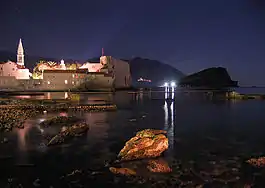
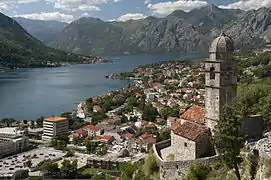

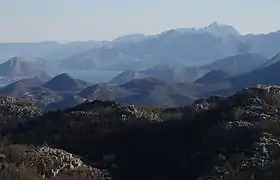


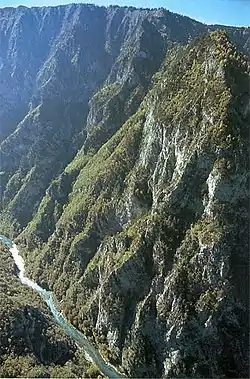
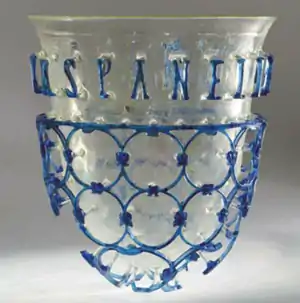
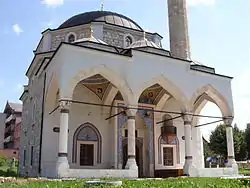

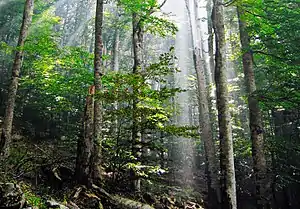

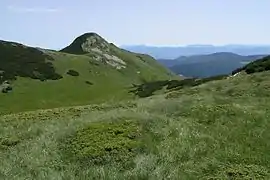




_01.jpg.webp)

